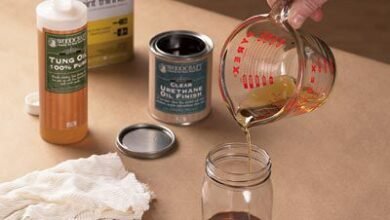1. What is Shellac?
Shellac is a natural resin secreted by the female lac bug (Laccifer lacca) on trees in Southeast Asia. Processed into flakes, it’s dissolved in ethanol to create a versatile wood finish. Unlike synthetic finishes, shellac is renewable, biodegradable, and food-safe once cured. The DVD highlights its historical use in fine furniture and musical instruments, emphasizing its organic origins and non-toxic properties compared to modern alternatives.
2. Why Use Shellac?
Vondriska and Munkittrick extol shellac’s rapid drying time (minutes between coats), excellent adhesion, and compatibility with most finishes. Its non-toxic nature makes it ideal for children’s toys or kitchenware. Unlike polyurethane, shellac is easily repairable and doesn’t yellow over time. It also resists bleed-through from tannins in woods like cherry or oak.
3. Types of Shellac
- Flakes vs. Premixed: Flakes offer customization, while premixed (e.g., Zinsser) is convenient but has a shorter shelf life (~1 year).
- Waxed vs. Dewaxed: Dewaxed (e.g., Super Blonde) is critical as a seal coat under other finishes (e.g., lacquer), while waxed adds warmth but limits compatibility.
- Colors: Ranges from clear (Super Blonde) to deep amber (Garnet), affecting the wood’s final hue.
4. Mix Your Own Shellac
- Ratios: A 1–3 lb “cut” (ounces of flakes per pint of alcohol) balances viscosity and drying time. A 2 lb cut is common for brushing.
- Process: Use denatured ethanol; dissolve flakes in a glass jar, stirring periodically. Strain through cheesecloth to remove impurities.
- Storage: Keep in airtight containers, refrigerated to extend shelf life. Premixed shellac expires when it no longer forms a skin when dried.
5. Applying Shellac
- Brushing: Use a high-quality natural bristle brush; work quickly in thin, overlapping strokes to avoid streaks.
- Padding/French Polishing: A lint-free pad applies thin layers in circular motions, building a high-gloss finish.
- Spraying: For large projects, dilute to a 1 lb cut. Add a drop of linseed oil to reduce drag when padding.
- Drying: Sand lightly with 320-grit paper between coats. Avoid thick coats to prevent clouding.
6. Shellac as a Turning Finish
Ideal for lathe work due to rapid drying; apply with a cloth while the piece spins. Multiple coats can be built in a single session. Enhances figured wood without obscuring grain. Buff with steel wool for a satin sheen.
7. Shellac as a Seal Coat
Prevents blotchiness in porous woods like pine under stain. Dewaxed shellac ensures adhesion of topcoats (e.g., water-based polyurethane). Apply a 1 lb cut, let dry, then sand lightly before proceeding.
8. Shellac as a Top Coat
Best for low-wear items (picture frames, decorative boxes). Build gloss with 5–6 thin coats, polished with rottenstone or pumice. While less durable than polyurethane, it offers a warm, tactile finish that ages gracefully.
9. Repairing Shellac
- Spot Repairs: Dab alcohol to reactivate the finish, then blend in fresh shellac.
- Burn-Ins: Melt shellac sticks into dents using a heated knife.
- Refinishing: Lightly sand and recoat damaged areas; shellac’s solubility allows seamless integration.
Expert Tips Highlighted:
- Speed Tricks: Use a spray gun for large surfaces; add a retarder (e.g., glycerin) for slower drying when brushing.
- Myth Busting: Despite perceptions, properly applied shellac is durable for centuries, as seen in antiques.
- Safety: Ensure ventilation when using alcohol; store shellac away from flames.
Conclusion:
Shellac’s versatility, urging woodworkers to embrace its eco-friendly, user-friendly nature. The DVD demystifies mixing and application, positioning shellac as a timeless, adaptable finish for both traditional and modern projects.


